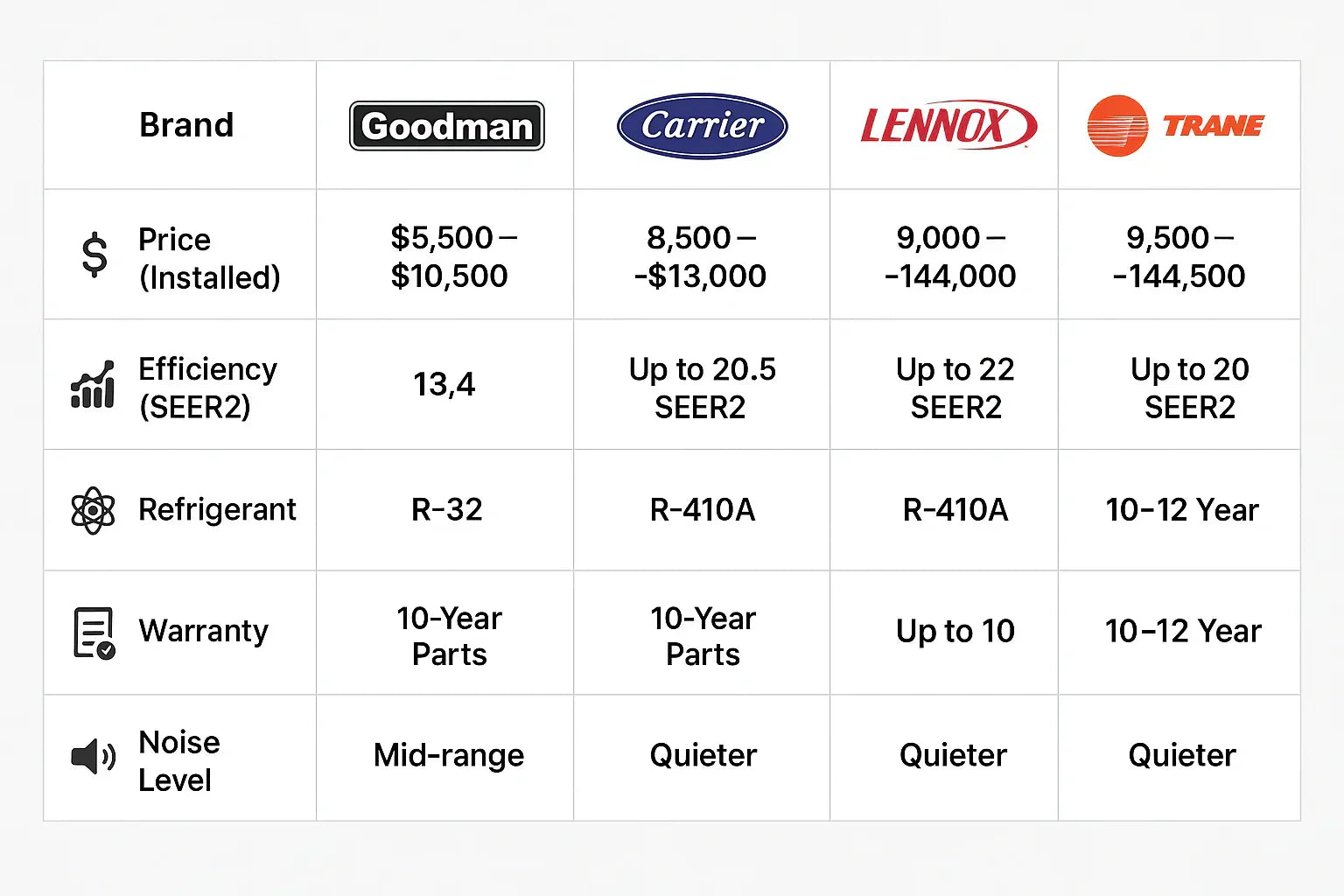When Mark began shopping for a new 5-ton air conditioner, he kept running into the same four names: Goodman, Carrier, Lennox, and Trane. Each brand has its fans, each promises reliability, and each comes with very different price tags.
But with Goodman’s new 5 Ton 13.4 SEER2 R-32 Condenser (Model GLXS3B6010), the conversation is changing. For homeowners like Mark, the question isn’t just “which brand is best?” — it’s “which brand is right for my home, budget, and long-term plans?”
This guide compares Goodman vs. Carrier, Lennox, and Trane, focusing on cost, efficiency, refrigerant, warranty, maintenance, and overall value.
🏷️ Price & Value: Goodman as the Budget-Friendly Choice
The first thing Mark noticed was the huge gap in pricing.
-
Goodman 5-Ton (GLXS3B6010): Typically $3,000–$5,500 for equipment. Installed, total cost lands between $5,500–$10,500 depending on ductwork and labor.
-
Carrier 5-Ton Infinity or Comfort Series: Equipment $4,500–$7,500, installed $8,500–$13,000.
-
Lennox 5-Ton Elite/Signature Series: Equipment $5,000–$8,000, installed $9,000–$14,000.
-
Trane 5-Ton XV Series: Equipment $5,500–$8,500, installed $9,500–$14,500.
👉 AC cost guide confirms these ranges.
Mark’s take: Goodman is almost always the most affordable 5-ton option, which makes it ideal for budget-conscious buyers. Carrier, Lennox, and Trane lean premium, often charging thousands more for similar capacity.
⚡ Efficiency Ratings (SEER2): Baseline vs. Premium
Efficiency is where the premium brands shine.
-
Goodman GLXS3B6010: 13.4 SEER2 (meets DOE’s new baseline standard).
-
Carrier Infinity Series: Up to 20.5 SEER2.
-
Lennox Signature Series: Up to 22 SEER2 (industry-leading efficiency).
-
Trane XV20i: Up to 20 SEER2.
👉 DOE SEER2 standards outline why 13.4 SEER2 is the new national minimum.
Mark’s take: If you live in a hot, high-electricity-cost region, a premium unit’s efficiency can pay off over time. But for many homeowners, Goodman’s 13.4 SEER2 is enough to keep bills reasonable without overspending upfront.
🌎 Refrigerant Technology: R-32 vs. R-410A
One of the biggest differences in 2025 is refrigerant choice.
-
Goodman GLXS3B6010: Uses R-32 refrigerant, which:
-
Has lower Global Warming Potential (GWP) than R-410A.
-
Requires less refrigerant to deliver the same cooling.
-
Meets EPA’s 2025 refrigerant phase-down rules.
-
-
Carrier, Lennox, Trane: Still selling many R-410A units, though beginning transitions to R-32 or R-454B.
👉 EPA SNAP refrigerant program details these regulatory changes.
Mark’s take: Choosing Goodman today means being future-proof. Buying an R-410A system in 2025 could create refrigerant servicing challenges down the road.
🧾 Warranty & Reliability
One of Goodman’s strongest selling points is its warranty.
-
Goodman: 10-year limited parts warranty (with registration).
-
Carrier: 10 years (parts), unit replacement coverage on select models.
-
Lennox: 10 years (elite models), 5 years on base lines unless extended.
-
Trane: 10–12 years depending on tier.
Reliability perception:
-
Goodman: Solid when installed correctly, but reputation suffers due to cut-rate installs.
-
Carrier: Consistently high satisfaction.
-
Lennox: Great efficiency but parts availability is costly.
-
Trane: Marketed as “hard to stop,” seen as premium durable.
Mark’s take: With proper installation, Goodman can last 12–15 years, same as its competitors.
🔊 Noise Levels & Comfort
Noise is another area where premium brands outperform.
-
Goodman GLXS3B6010: Reliable but not as quiet (mid-range dB rating).
-
Carrier Infinity & Trane XV units: Whisper-quiet, often 55–60 dB.
-
Lennox Signature: Known for SilentComfort™ technology.
👉 Lennox’s SilentComfort explanation.
Mark’s take: If you live in a dense neighborhood or have outdoor units near bedrooms/patios, Carrier, Trane, or Lennox might be worth the premium.
🛠️ Installation & Maintenance
Installation quality often matters more than brand.
-
Goodman: Widely available parts, lots of contractors. Lower maintenance cost.
-
Carrier/Lennox/Trane: Typically require certified dealers, limiting installer choice and often raising labor costs.
👉 Energy Star’s AC maintenance tips.
Mark’s take: Goodman wins for ease of service. Carrier/Lennox/Trane deliver premium features but can mean higher repair bills and fewer independent contractors.
📊 Brand Reputation & Reviews
How homeowners perceive each brand:
-
Goodman: Best value, strong warranty, reputation held back by cheap installs.
-
Carrier: Premium comfort, middle-to-high pricing, very reliable.
-
Lennox: Most efficient, but parts are expensive and not always easy to source.
-
Trane: Viewed as rugged and premium, but among the most expensive.
👉 Consumer Reports’ AC ratings confirm these general perceptions.
💡 Who Should Choose Goodman vs. Competitors?
-
Goodman: Perfect for budget-conscious homeowners who want solid performance at the lowest cost.
-
Carrier: A balance of premium comfort and reasonable pricing.
-
Lennox: For efficiency geeks who want the lowest possible electric bills.
-
Trane: For homeowners who want brand prestige and rugged reliability.
✅ Final Thoughts: Mark’s Takeaway
When Mark compared quotes, the numbers spoke loud and clear:
-
Goodman’s 5-ton R-32 condenser cost $3,000–$5,000 less than Trane or Lennox equivalents.
-
Its 13.4 SEER2 efficiency met all federal standards and was enough for his home.
-
And most importantly, it was already R-32 ready, meaning his system won’t be outdated by refrigerant rules in just a few years.
For Mark, Goodman won on value, warranty, and future-proof refrigerant technology.
If you’re a homeowner deciding between Goodman, Carrier, Lennox, or Trane, the right answer comes down to:
-
Budget vs. efficiency.
-
Future-proof refrigerant vs. current inventory deals.
-
Noise/comfort extras vs. baseline reliability.
But one thing’s certain: Goodman is no longer just the “budget brand”—it’s a real competitor to the industry’s biggest names.
In the next topic we will know more about: How Much Does a 5-Ton R-32 AC Cost in 2025? Real-World Pricing & Budgeting Guide







